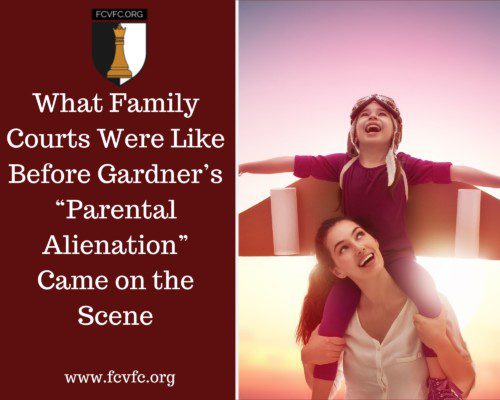 Once upon a time (before 1980) the family court systems across the U.S., however imperfect, could be said to have made a good faith effort to deal with divorce and custody litigation and resolution in a legal/business-like judicious manner.
Once upon a time (before 1980) the family court systems across the U.S., however imperfect, could be said to have made a good faith effort to deal with divorce and custody litigation and resolution in a legal/business-like judicious manner.
Judges took off their black robes and met with children in their chambers or in play rooms next to their quarters. They actually spoke with children, solicited their thoughts, feelings, accounts of events. There was an attempt in an informal, non-threatening manner to understand and respect the child’s thoughts, feelings and recommendations for their own futures.
Files were sealed to protect privacy, not to conceal lies or the presence of damning evidence.
Judges explained their directives and rulings, provided insight into their reasoning and judgment and also offered avenues for dispute and alteration. Before the FCVFC existed there was mediation and dispute resolution.
When those involved in the legal process work together for the benefit of all
Three teen brothers between the ages of 13 and 16 not only refused to have any dealings with their father but vociferously raised their voices in court through police reports, as witnesses to the abuse of their father against their mother and the bullying, humiliating sexual advances toward their little sister who was 11 years old at the time. I was the clinical evaluator and expert on a case in 1997 when working with a NJ ADA.
The judge agreed to meet with the boys and their sister separately in chambers. The children were each transported to the court via the car service and bodyguards associated with The Family Resolution Center, LLC, the mediation division of my private practice.
Records sealed based on the testimony of the children, reports provided by me and the ADA, resolved that full custody was ordered to the mother for all minors. The father was afforded the opportunity of seeking confidential treatment with a therapist approved and thoroughly supported by all parties, with the understanding that the father’s own personal history of family violence and abuse designated him as a victim of his own family abuse and that he should be afforded the opportunity to reconcile and remediate the traumas of his own past.
Among the unique factors of this case was that cooperation on the part of the abuser parent was enlisted because of pressure from the court.
The automatic agreement (that the children were property of the father) was not allowed to move forward, and the rights and protections of the children were in fact afforded full and complete recognition and respect.
The therapeutic issues promoted by the court’s authority in making it possible for confidential therapeutic intervention and mediated services were allowed by the court, which expanded a realm of opportunity and confidentiality. It also allowed an unusual level of good faith negotiations to take place. As a result, the ability to negotiation beyond property and material self-interest into deeper emotional connections and family commitments did in fact play a meaningful role.
The nuances of custody division interdicted with therapeutic intervention and flexibility in common spaces for all parties to make good faith attempts to rehabilitate relationships on a confidential basis, which allowed for a unique outcome that was not the result of an autocratic disposition of the judge.
I can state that over a period of time, and not a terribly extended period of time, relationships did mend and significantly heal to the benefit of all parties.
However, the attorneys for the father aggressively fought against the therapeutic process and mediated the process. It was only after the father dismissed his attorneys that a satisfactory confidential long term agreement involving the cooperation of all parties over time was allowed to move forward.
This case then became a standard of operation that developed a framework for future similarly highly emotional and controversial cases moving forward, all of which involved severe mental illness and domestic violence.
All of those cases also were fought against by attorneys who wanted to act in a black and white way stating that the mother was a liar, that the children were liars and that custody should be afforded to the father. The attorneys did not want the children to testify and did not want the maternal domestic violence victim to testify.
This particular set of cases was unique as to the types of emotional and volatile cases that present themselves in family court. They were unique also in terms of the intergenerational history of family violence and mental illness, as well as the presence of love and fundamental desire to undo generations of domestic violence, sexual abuse, and family chaos.
Had it not been for the presence of judges in these situations that were willing to work with all family members who were diagnostically considered victims of their own familial chaos and current historical recapitulation and the willingness to facilitate a process that went beyond an authoritative judgment and disposition, the historic benefits that were achieved for these families would not have occurred.
It must be noted also that the phases of work and interventions enlisted for these families were multi-layered. No simplistic autocratic intervention could have possibly achieved the kind of long-term results and healing benefits that were accomplished in this course of action.
There are other very dramatic examples of other similar cases that involved intergenerational violence, sexual abuse, and mental illness that the Foundation for Child Victims of the Family Courts was involved in. It was not without conflict and argument with the court, but that argument was allowed to take place and to proceed and ultimately agreed upon.
All parties experienced a sense of great satisfaction that was followed and documented over time and proved to be as successful if not more successful than could have possibly been anticipated in the beginning – financially, emotionally, and legally.
This form of cooperation between psychotherapeutic, medical, legal, and psychiatric interventions in fact became the platform for the nonprofit Families in Transition. FIT formally implemented psychotherapy, mediation, and arbitration, as a protocol for pulling cases out of litigation and into ongoing court oversight and support.
The Falsified Affidavit
Little Johnny, age 5, and his 7-year-old sister were subjects of a bitter child custody dispute.
Johnny was the target of his father’s molestation. His sister was the witness to his father’s sexual molestation and her baby brother’s agony, growing rage, despair and retreat into childhood madness. The children’s mother was a documented drug abuser of methamphetamine with a criminal record for petty theft. Multiple drug treatment interventions had failed and her motivation for improving her situation was nonexistent. She had unsupervised visitation privileges with her children, and her presence as an affectionate but ineffectual, superficial figure did little to ameliorate their suffering.
The children’s grandmother was a wealthy, well known scion of a fashionable society family and it was her presence that supplied the legal intervention, power, and drive to prosecute her grandchildren’s abuser.
Their biological father was a handsome body builder “boy toy” who was seeking custody and child support of both children and was on his way to receiving both, despite multiple court interventions to present evidence of the father’s unfitness, the children’s emotional and functional deterioration in his care.
A vignette that depicts the evolution of judicial “discretion” to judicial lies, larceny and abuse of the legal process involves the episode in which I was a witness in court before the judge presiding over this case. My presence on this occasion was to contest evidence submitted, purported to be a signed, notarized Affidavit from myself.
The document prepared by the Plaintiff/Perpetrator attested under oath to the “fact” that I as the case evaluator saw no evidence of child abuse when I interviewed and worked therapeutically with these two children.
However, the document did not contain my signature and was never agreed to by me. I had never met with the attorney for the Plaintiff, though I did meet confidentially with the children’s father and never betrayed his confidence with regard to our private discussions about the children and his own history of abuse.
I testified to the limited fact that the signature was not mine and could prove that the signature was not mine.
The judge overruled my testimony and admitted the document into the record, dismissing the complaint against the sexual abuser of the child and granting him full custody and generous child support.
The case went on to be contested. Full custody and decision making for both children was ultimately granted to the maternal grandmother.
The descent into a court system of insanity and perversion
The practice of Family law guided by the Uniform Marriage and Divorce Act 402, 9A ULA.561 (1987) was provided with guidance as to factors that were to be included in determining best interests of the child.
Those factors articulated concerns for the child’s wishes, adjustment, stated relationship with each parent and preferences as to parental custodian with factual support demonstrated by mental and physical health, school and social adjustment.
Judicial discretion in these matters was paramount and upheld unless the judge refused to consider a factor that the Appellate Court believed, as a matter of law, were in fact a part of “best interests” or that violated constitutional or statutory mandates. Judicial discretion, once a loosely governed and managed legal process, was driven by and dealt with as a reasonably humanitarian process meant to facilitate humane, confidential, respectful communications involving intimate family relationships and interactions. Judicial preference may have more often reflected local community standards and as such as that reflected in Painter vs. Bannister which stressed the “desirable traits of a citizen” .
Implicit elements of best interest law suggest an almost infinite term of jurisdictional discretion, as judges appear to weigh desired outcomes of their decisions as factors which appear as indeterminate and within the range of orders that we see directed by the court. It is not only a presence and immediate factor but also has orders that impact 10 and 20 years into the future. Immediate welfare and wellbeing are correlated by the impact of judicial orders of 10, 20, and more years into the future.
Among the issues implicit in judicial discretion is a judgment by authorities as to the desirable traits by which subjects of the court must adhere.
In Painter vs. Bannister a judge awarded custody of a 7-year-old child whose parents were deceased not to the biological father of the child but to the grandparents of the child whom the judge criticized as a “political liberal living in an unpainted house…” The court stated that the father would provide the child with an unstable and unconventional bohemian and probably intellectually stimulating home, but the grandparents who were awarded custody were said to be church going, offering a stable Midwest background. The statements of the judge indicated that the judge unhesitatingly “believed that the grandparents’ home was more stable for the child and that security and stability of a home were more important.”
The injection of a statement of values determining fitness favoring divergent personalities, education, social and financial resources reflects the judge’s own view as to what represents desirable traits and predictions as to the parent who is more likely to be a socializing force. In the Painter case, the judge was guided by a sense of the values of the community and thus based judgment on the so-called values of the community meant to reduce arbitrariness and to induce a sense of traditionalism. The subjective values of what would make the best determination for a child’s future separated from norms of inheritance set a precedent for shaping the scope and decision-making process that became injected into the custody evaluation process and the discretion of judges. It laid the groundwork for an ultimate conclusion of best interests that are value laden, unscientific, and preserved to the discretion of the judge.



